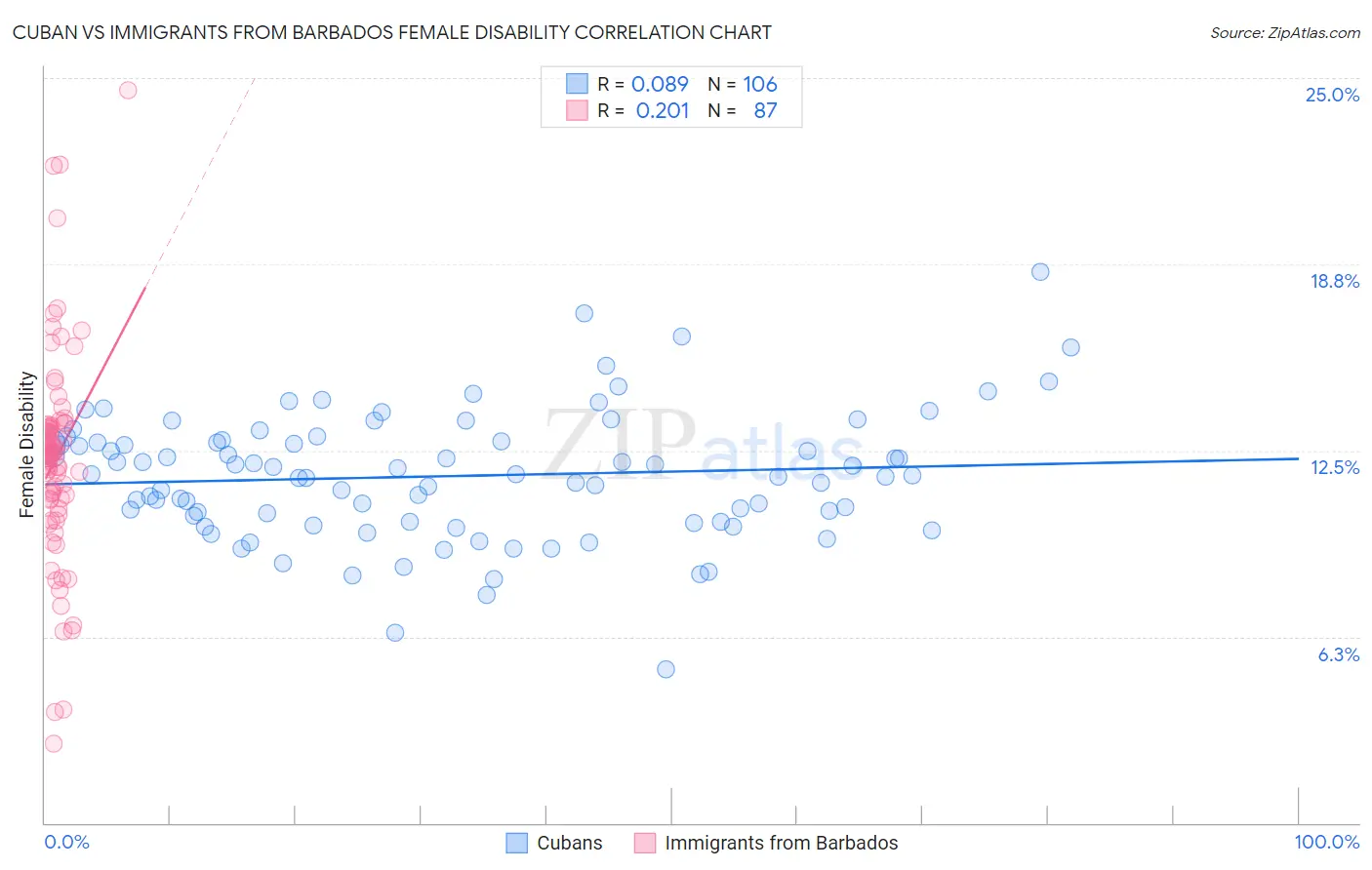Cuban vs Immigrants from Barbados Female Disability
COMPARE
Cuban
Immigrants from Barbados
Female Disability
Female Disability Comparison
Cubans
Immigrants from Barbados
12.3%
FEMALE DISABILITY
36.5/ 100
METRIC RATING
183rd/ 347
METRIC RANK
12.3%
FEMALE DISABILITY
21.1/ 100
METRIC RATING
203rd/ 347
METRIC RANK
Cuban vs Immigrants from Barbados Female Disability Correlation Chart
The statistical analysis conducted on geographies consisting of 449,245,212 people shows a slight positive correlation between the proportion of Cubans and percentage of females with a disability in the United States with a correlation coefficient (R) of 0.089 and weighted average of 12.3%. Similarly, the statistical analysis conducted on geographies consisting of 112,784,400 people shows a weak positive correlation between the proportion of Immigrants from Barbados and percentage of females with a disability in the United States with a correlation coefficient (R) of 0.201 and weighted average of 12.3%, a difference of 0.71%.

Female Disability Correlation Summary
| Measurement | Cuban | Immigrants from Barbados |
| Minimum | 5.2% | 2.7% |
| Maximum | 18.5% | 24.6% |
| Range | 13.3% | 21.9% |
| Mean | 11.6% | 12.2% |
| Median | 11.7% | 12.4% |
| Interquartile 25% (IQ1) | 10.1% | 10.9% |
| Interquartile 75% (IQ3) | 12.8% | 13.3% |
| Interquartile Range (IQR) | 2.7% | 2.4% |
| Standard Deviation (Sample) | 2.1% | 3.5% |
| Standard Deviation (Population) | 2.1% | 3.5% |
Demographics Similar to Cubans and Immigrants from Barbados by Female Disability
In terms of female disability, the demographic groups most similar to Cubans are Iraqi (12.3%, a difference of 0.020%), Immigrants from Uzbekistan (12.3%, a difference of 0.10%), Austrian (12.3%, a difference of 0.13%), Serbian (12.3%, a difference of 0.14%), and Immigrants from North America (12.3%, a difference of 0.15%). Similarly, the demographic groups most similar to Immigrants from Barbados are Somali (12.3%, a difference of 0.020%), Chinese (12.3%, a difference of 0.050%), Trinidadian and Tobagonian (12.3%, a difference of 0.070%), Immigrants from Trinidad and Tobago (12.3%, a difference of 0.19%), and Mexican American Indian (12.3%, a difference of 0.20%).
| Demographics | Rating | Rank | Female Disability |
| Cubans | 36.5 /100 | #183 | Fair 12.3% |
| Iraqis | 36.0 /100 | #184 | Fair 12.3% |
| Immigrants | Uzbekistan | 33.9 /100 | #185 | Fair 12.3% |
| Austrians | 33.3 /100 | #186 | Fair 12.3% |
| Serbians | 33.1 /100 | #187 | Fair 12.3% |
| Immigrants | North America | 32.8 /100 | #188 | Fair 12.3% |
| Immigrants | Albania | 31.6 /100 | #189 | Fair 12.3% |
| Immigrants | Honduras | 31.3 /100 | #190 | Fair 12.3% |
| Armenians | 29.7 /100 | #191 | Fair 12.3% |
| Immigrants | Western Africa | 29.2 /100 | #192 | Fair 12.3% |
| Northern Europeans | 27.5 /100 | #193 | Fair 12.3% |
| Ukrainians | 27.2 /100 | #194 | Fair 12.3% |
| Swedes | 26.6 /100 | #195 | Fair 12.3% |
| Immigrants | Panama | 25.5 /100 | #196 | Fair 12.3% |
| Hondurans | 25.4 /100 | #197 | Fair 12.3% |
| Mexican American Indians | 24.9 /100 | #198 | Fair 12.3% |
| Immigrants | Trinidad and Tobago | 24.7 /100 | #199 | Fair 12.3% |
| Trinidadians and Tobagonians | 22.4 /100 | #200 | Fair 12.3% |
| Chinese | 22.1 /100 | #201 | Fair 12.3% |
| Somalis | 21.5 /100 | #202 | Fair 12.3% |
| Immigrants | Barbados | 21.1 /100 | #203 | Fair 12.3% |